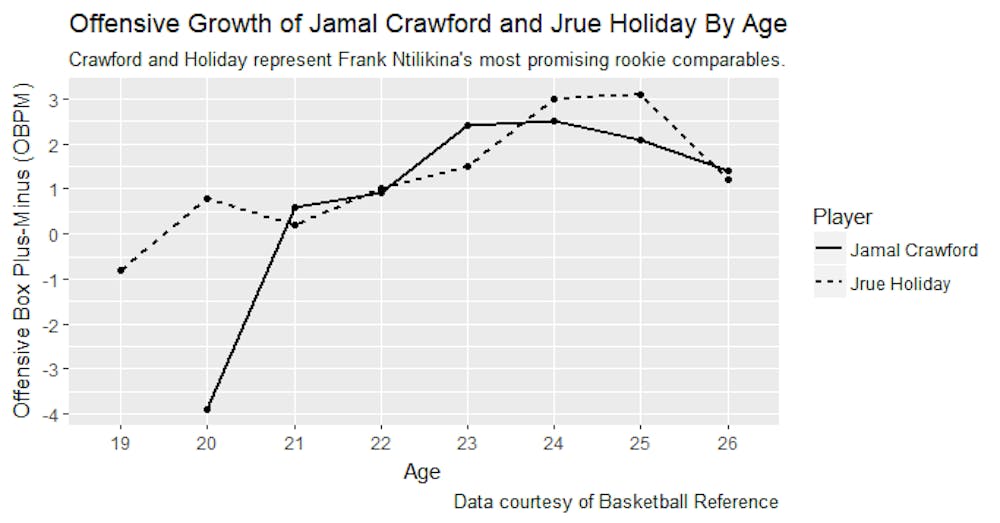Through 21 games, the New York Knicks, with a record of 11-10 and the seventh-best point differential in the Eastern Conference, have substantially outperformed their preseason projections. FiveThirtyEight’s CARMELO ratings pegged the Knicks for just 30 wins at the start of the season. Just about a quarter of the way through the year, New York has already improved its forecast by seven wins and boosted its chance of making the playoffs to 29 percent.
Much of the team’s success can be attributed to Kristaps Porzingis making the leap to stardom in his third season. But Frank Ntilikina, New York’s rookie point guard and last year’s eighth overall pick, has generated his own share of buzz — and for good reason. Ntilikina, who stands at 6’5” with a 7-foot wingspan, has made an immediate impact defensively. The Knicks defend about a point better per 100 possessions with the rook on the floor, per NBA.com, and Ntilikina has racked up the highest steal percentage of any rookie guard with more than 100 minutes played, according to Basketball Reference’s Play Index.
But for all his defensive prowess, Ntilikina has struggled mightily on offense to start his career. Of the NBA’s most highly-touted rookie point guards — including Ben Simmons, Lonzo Ball, De’Aaron Fox and Dennis Smith Jr. — Ntilikina owns the lowest assist percentage, the highest turnover percentage and the second-worst true shooting percentage. Ntilikina is a 19-year-old with less than 400 NBA minutes under his belt, so it’s far from time to panic about his development. Still, for a New York team that’s banking on the Porzingis-Ntilikina pairing to drag the franchise out of mediocrity, it’s worth asking: What is reasonable to expect out of Ntilikina’s career?
To get a grasp of how guards with playing styles similar to Ntilikina’s progressed after their rookie seasons, I dug up the statistics of every first-year guard that appeared in at least thirty games since the beginning of the three-point era (the 1979-1980 season) using the Play Index. I used model-based clustering to identify the three different “types” of guards: non-shooting playmakers, who tend to boast high assist totals and rate well defensively; shooting playmakers, who compensate for their lack of defensive skill with ability to space the floor; and combo guards who shoot, rebound and defend, but do little to make their teammates better.
With his relatively high assist and three-point attempt rates, Ntilikina’s offensive potential fits that of a shooting playmaker, though he has exhibited more defensive potential than is typical of that type of player. Contemporary shooting playmakers include stars like Damian Lillard, Stephen Curry and Isaiah Thomas.
Those comparables seemed too broad, so I drilled deeper by finding rookie guards classified as shooting playmakers who posted three-point, free throw, usage, rebounding, assist, turnover and steal tendencies in Ntilikina’s range. Using this methodology yields a list of guards who made their debuts at age 22 and over — like Nando De Colo, Steve Blake and Phil Pressey. But a pair of younger players stand out from the list: Jrue Holiday and Jamal Crawford, who entered the league at 19 and 20, respectively.
As rookies, Holiday and Crawford displayed the same mix of high three-point attempt volume, low free-throw frequency and spotty playmaking that Ntilikina has over his first 18 games. They’re also both tall, long defenders, unlike many of the other guards clustered as shooting playmakers. The one major caveat: Neither Holiday nor Crawford was as bricky in their first year as Ntilikina has been shooting from the perimeter. Holiday shot 39 percent from three and 76 percent from the free throw line as a rookie, while Crawford shot 35 percent and 79 percent, respectively. Ntilikina’s shooting numbers currently sit at just 25 percent from three and 64 percent from the line.
He has only attempted 32 total threes and 14 free throws this season, so it’s possible that despite the pre-draft concerns about his shooting, Ntilikina’s true perimeter accuracy is closer to that of Holiday and Crawford than his present stats indicate. It might be smart to think of Holiday and Crawford as best-case scenarios for Ntilikina’s offensive development, players representative of his ceiling should he turn into a reliable deep threat. With that in mind, here’s a chart of Holiday and Crawford’s offensive output by age as measured by Offensive Box Plus-Minus, a stat from Basketball Reference that estimates a player’s offensive contributions in points per 100 possessions above or below average.
Considering his defensive prowess, if Ntilikina can reach the 1.5 to 2.5 OBPM range that Holiday and Crawford began occupying around their fourth seasons, he’ll be a borderline all-star and a key two-way cog that can mesh with any set of teammates seamlessly.
It’s likely Ntilikina will approach Holiday’s aptitude as a playmaker — he already possesses solid vision and his decision-making and ball security will improve as he matures into his early 20s. The concern is that his jump shot never materializes into a real weapon, clogging vital passing and driving lanes on offense.
Ntilikina will always have a role as a defensive ace, especially as he fills out and learns the intricacies of NBA-level defense. But the Knicks didn’t pass on Smith at pick number eight to draft a defensive stopper without elite athleticism and a broken jumper, particularly as the NBA continues to place more value on the three-point shot than ever.
New York needs at least one more star to pair with Porzingis to become a factor in the east, a task that will become daunting if Ntilikina’s icy shooting proves to be symptomatic of something more than teenage growing pains. Ntilikina’s defense and passing alone gives him a high floor, but for the Knicks to challenge Boston and Philadelphia in a few years, he’ll need to develop into a threat from distance.
Sam Grigo ’18 can be reached at samuel_grigo@brown.edu. Please send responses to this opinion to letters@browndailyherald.com and other op-eds to opinions@browndailyherald.com.





